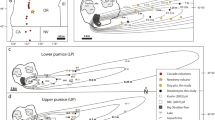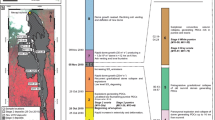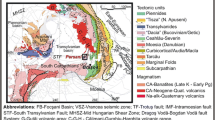Abstract
The Monte Nuovo eruption is the most recent event that occurred at Phlegrean Fields (Italy) and lasted from 29 September to 6 October 1538. It was characterized by 2 days of quasi-sustained phreatomagmatic activity generating pumice-bearing pyroclastic density currents and forming a 130-m-high tuff cone (Lower Member deposits). The activity resumed after a pause of 2 days with two discrete Vulcanian explosions that emplaced radially distributed, scoria-bearing pyroclastic flows (Upper Member deposits). The juvenile products of Lower and Upper Members are, respectively, phenocryst-poor, light-coloured pumice and dark scoria fragments with K-phonolitic bulk compositions, identical in terms of both major and trace elements. Groundmass is formed by variable proportions of K-feldspar and glass, along with minor sodalite and Fe-Ti oxide present in the most crystallized samples. Investigations of groundmass compositions and textures were performed to assess the mechanisms of magma ascent, degassing and fragmentation along the conduit and implications for the eruptive dynamics. In pumice of the Lower Member groundmass crystal content increases from 13 to 28 vol% from the base to the top of the sequence. Products of the Upper Member consist of clasts with a groundmass crystal content between 30 and 40 vol% and of totally crystallized fragments. Crystal size distributions of groundmass feldspars shift from a single population at the base of the Lower Member to a double population in the remaining part of the sequence. The average size of both populations regularly increases from the Lower to the Upper Member. Crystal number density increases by two orders of magnitude from the Lower to the Upper Member, suggesting that nucleation dominated during the second phase of the eruption. The overall morphological, compositional and textural data suggest that the juvenile components of the Monte Nuovo eruption are likely to record variations of the magma properties within the conduit. The different textures of pumice clasts from the Lower Member possibly reflect horizontal gradients of the physical properties (P, T) of the ascending magma column, while scoriae from the second phase are thought to result from the disruption of a slowly rising plug crystallizing in response to degassing. In particular, crystal size distribution data point to syn-eruptive degassing-induced crystallization as responsible for the transition in eruptive style from the first to the second phase of the eruption. This mechanism not only has been proved to profoundly affect the dynamics of dome-forming calc-alkaline eruptions, but may also have a strong influence in driving the eruption dynamics of alkaline magmas of intermediate to evolved compositions.










Similar content being viewed by others
References
Abbott RN (1978) Peritectic relations in the system An-Ab-Or-Qz-H2O. Can Mineral 16:245–256
Alidibirov MA (1994) A model for viscous magma fragmentation during volcanic blast. Bull Volcanol 56:459–465
Alidibirov MA, Dingwell DB (2000) Three fragmentation mechanisms for highly viscous magma under rapid decompression. J Volcanol Geotherm Res 100:413–421
Carroll MR, Blank JG (1997) The solubility of H2O in phonolitic melts. Am Mineral 82:549–556
Cashman KV (1992) Groundmass crystallization of Mount St. Helens dacite, 1980–1986: A tool for interpreting shallow magmatic processes. Contrib Mineral Petrol 109:431–449
Cashman KV, Marsh BD (1988) Crystal size distribution (CSD) in rocks and the kinetics and dynamics of crystallization II. Makaopuhi lava lake. Contrib Mineral Petrol 99:292–305
Cashman KV, Blundy J (2000) Degassing and crystallization of ascending andesite and dacite. Phil Trans Roy Soc 358:1487–1513
Cashman KV, Sturtevant B, Papale P, Navon O (2000) Magmatic fragmentation. In: Sigurdsson H (ed) Encyclopedia of volcanoes. Academic Press, New York, pp 421–430
Da Toledo PG (1538) Ragionamento del terremoto, del Nuovo Monte, dell’aprimento di terra in Pozzolo nell’anno 1538 e della significazione di essi per Pietro Giacomo Da Toledo. Napoli, Sultzbach, 1538
Deino AL, Curtis GH, Rosi M (1992) 40Ar/39Ar dating of the Campanian Ignimbrite, Campanian Region, Italy. 29th International Geological Congress, Japan, Abstracts 3:2654
Deino AL, Curtis GH, Southon J, Terrasi F, Campajola L, Orsi G (1994) 14C and 40Ar/39Ar dating of the Campanian Ignimbrite, Phlegrean Fields, Italy. Berkeley, USA, 8th International Conference on Geochronology, Cosmochronology and Isotope Geology, Abstracts US Geol Surv Circ 1107:77
Del Nero F (1538) Sul terremoto di Pozzuoli, dal quale ebbe origine la Montagna Nuova, nel 1538
Delli Falconi MA (1538) Dell’incendio di Pozzuoli nel MDXXXVIII. Napoli 1538
Devine JD, Rutherford MJ, Gardner JE (1998) Petrologic determination of ascent rates for the 1995–1997 Soufrière Hill volcano andesitic magma. Geophys Res Lett 25:3673–367
Di Vito M, Lirer L, Mastrolorenzo G, Rolandi G (1987) The 1538 Monte Nuovo eruption (Campi Flegrei, Italy). Bull Volcanol 49:608–615
Dvorak J, Gasparini P (1991) History of earthquakes and vertical ground movement in Campi Flegrei caldera, southern Italy: comparison of precursory events to the AD 1538 eruption of Monte Nuovo and of activity since 1968. J Volcanol Geotherm Res 48:77–92
Eichelberger JC, Carrigan CR, Westrich HR, Price RH (1986) Non-explosive silicic volcanism. Nature 323:598–602
Fenn PM (1977) The nucleation and growth of alkali feldspars from hydrous melts. Can Mineral 15:135–161
Fink J, Anderson S, Manley C (1992) Textural constrains on effusive silicic volcanism: beyond the permeable foam model. J Geophys Res 97:9073–9083
Folch A, Marti J (1998) The generation of overpressure in felsic magma chambers by replenishment. Earth Planet Sci Lett 163:301–314
Freundt A, Tait SR (1986) The entrainment of high-viscosity magma into low-viscosity magma in eruption conduits. Bull Volcanol 48:325–339
Gardner CA, Cashman KV, Neal CA (1998) Tephra-fall deposits from the 1992 eruption of Crater Peak, Alaska: implication of clast texture for eruption processes. Bull Volcanol 59:537–555
Giordano D, Dingwell BD (2003) Non-Arrhenian multicomponent melt viscosità: a model. Earth Planet Sci Lett 208:337–349
Gurioli L, Houghton B, Cashman CV, Cioni R (2004) Complex changes in eruption dynamics and the transition between plinian and phreatomagmatic activity during the 79 AD eruption of Vesuvius. Bull Volcanol (in press)
Hamilton W (1776) Campi Flegrei observations on the volcanoes of the two Sicilies. de Fabris P (ed) Naples
Hammer JE, Cashman KV, Hoblitt R, Newman S (1999) Degassing and microlite crystallization during the pre-climatic events of the 1991 eruption of the MT. Pinatubo, Philippines. Bull Volcanol 60:355–380
Hammer JE, Cashman KV, Voight B (2000) Magmatic processes revealed by textural and compositional trends in Merapi dome lavas. J Volcanol Geotherm Res 100:165–192
Hammer JE, Rutherford M (2002) An experimental study of the kinetics of decompression-induced crystallization in silicic melt. J Geophys Res 107:1–24
Higgins M (1994) Numerical modeling of crystal shapes in thin sections: estimation of crystal habit and true size. Am Mineral 79:113–119
Higgins M (2000) Measurements of crystal size distributions. Am Mineral 85:1105–1116
Hoover SR, Cashman KV, Manga M (2001) The yield strength of subliquidus basalts; experimental results. J Volcanol Geotherm Res 107:1–18
Houghton BF, Wilson CJN (1989) A vesicularity index for pyroclastic deposits. Bull Volcanol 51:451–462
Housh TB, Luhr JF (1991) Plagioclase-melt equilibria in hydrous systems. Am Mineral 76:477–492
Jaupart C, Allegre CJ (1991) Gas content, eruption rate and instabilities of eruption regime in silicic volcanoes. Earth Planet Sci Lett 102:413–429
Larsen JF, Gardner JE (2004) Experimental study of water degassing from phonolite melts: implications for volatiles oversaturation during magmatic ascent. J Volcanol Geotherm Res 134:109–124
Lejeune AM, Richet P (1995) Rheology of crystal-bearing silicate melts: an experimental study at high viscosities. J Geophys Res 100:4215–4230
Lirer L, Rolandi G, Di Vito M, Mastrolorenzo G (1987) L’eruzione del Monte Nuovo (1538) nei Campi Flegrei. Boll Soc Geol It 106:447–460
Lofgren G (1974) An experimental study of plagioclase crystal morphology: isothermal crystallization. Am J Sci 274:243–273
Marchesino F (1538) Copia di una lettera di Napoli che contiene li stupendi, et gran prodigi apparsi sopra Pozzolo. Napoli 1538
Marsh B (1988) Crystal size distributions (CSD) in rocks and the kinetics and dynamics of crystallization I. Theory. Contrib Mineral Petrol 99:277–291
Morrissey MM, Mastin LG (2000) Vulcanian eruptions. In: Sigurdsson H (ed) Encyclopedia of volcanoes. Academic, San Diego, pp 463–475
Morrissey MM, Zimanowski B, Wholetz K, Buettner R (2000) Phreatomagmatic fragmentation. In: Sigurdsson H (ed) Encyclopedia of volcanoes. Academic, San Diego, pp 431–445
Nakada S, Motomura Y (1999) Petrology of the 1991–1995 eruption at Unzen: effusion pulsation and groundmass crystallization. J Volcanol Geotherm Res 89:173–196
Nekvasil H, Burnham CW (1987) The calculated individual effects of pressure and water content on phase equilibria in the granite system. In: Magmatic processes: physicochemical principles. The Geochem Soc Spec Publ 1:433–445
Nekvasil H, Lindsley D (1990) Termination of the 2 feldspar + liquid curve in the system Ab-An-H2O at low H2O contents. Am Mineral 75:1071–1079
Orsi G, D’Antonio M, de Vita S, Gallo G (1992) The Neapolitan Yellow tuff, a large-magnitude trachytic phreatoplinian eruption: eruptive dynamics, magma withdrawal and caldera collapse. J Volcanol Geotherm Res 53:275–287
Orsi G, Civetta L, D’Antonio M, Di Girolamo P, Piochi M (1995) Step-filling and development of a three-layer magma chamber: the Neapolitan Yellow Tuff case history. J Volcanol Geotherm Res 67:291–312
Orsi G, De Vita S, Di Vito M (1996) The restless, resurgent Campi Flegrei nested caldera (Italy): constraints on its evolution and configuration. J Volcanol Geotherm Res 74:179–214
Orsi G, Civetta L, Del Gaudio C, de Vita S, Di Vito MA, Isaia R, Petrazzuoli SM, Ricciardi GP, Ricco C (1999) Short-term ground deformations and seismicity in the resurgent Campi Flegrei caldera (Italy): an example of active block-resurgence in a densely populated area. J Volcanol Geotherm Res 91:415–451
Pallister JS, Hoblitt RP, Meeker GP, Knight RJ, Siems DF (1996) Magma mixing at Mount Pinatubo: petrographic and chemical evidence from the 1991 deposits. In: Newhall CG, Punongbayan RS (eds) Fire and mud: eruptions and lahars of Mount Pinatubo, Philippines. University of Washington Press, Seattle, pp 687–732
Papale P (1999) Strain-induced magma fragmentation in explosive eruptions. Nature 397:425–428
Parascandola A (1946) Il Monte Nuovo e il Lago Lucrino. Boll Soc Nat 55:151–312
Paulick H, Franz G (1997) The color of pumice: case study on trachytic fall deposit, Meidob volcanic field, Sudan. Bull Volcanol 59:171–185
Polacci M, Papale P, Rosi M (2001) Textural heterogeneities in pumices from the climatic eruption of Mount Pinatubo, 15 June 1991, and implications for magma ascent dynamics. Bull Volcanol 63:83–97
Polacci M, Pioli L, Rosi M (2003) The Plinian phase of the Campanian Ignimbrite eruption (Phlegrean Fields. Italy): evidence from density measurements and textural characterization of pumice. Bull Volcanol 65:418–432
Porzio S (1551) De conflagrazione agri puteolani Simoni Portii Epistola. Napoli, Sultzbach, 1538, Floreantiae, 1551
Rosi M, Santacroce R (1984) Volcanic hazard assessment in the Phlegrean Fields: a contribution based on stratigraphic and historical data. Bull Volcanol 47 (2):359–370
Rosi M, Sbrana A (1987) Phlegrean Fields. Quaderno della ricerca scientifica, Vol 9:114
Rosi M, Landi P, Polacci M, Di Muro A, Zandomeneghi D (2004) Role of conduit shear on ascent of the crystal-rich magma feeding the 800-year-b.p. Plinian eruption of Quilotoa Volcano (Ecuador). Bull Volcanol 66:307–321
Saar MO, Manga M, Cashman KV, Fermouw S (2001) Numerical models of the onset of yield strength in crystal-melt suspensions. Earth Planet Sci Lett 187:367–379
Shaoxiong W, Nekvasil H (1994) SOLVCALC: an interactive graphics program package for calculating the ternary feldspar solvus and for two-feldspar geothermometry. Comput Geosci 20:1025–1040
Sohn YK, Chough SK (1992) The Ilchulbong tuff cone, Cheju Island, South Korea: depositional processes and evolution of an emergent, Surtseyan-type tuff cone. Sedimentology 39:523–544
Sparks RSJ (1997) Causes and consequences of pressurization in lava dome eruptions. Earth Planet Sci Lett 150:177–189
Sparks RSJ, Barclay J, Jaupart C, Mader HM, Phillips JC (1994) Physical aspects of magmatic degassing I. Experimental and theoretical constraints on vesiculations. In: Carroll MR, Holloway JR (eds) Volatile in magmas. Rev Mineral 30:413–445
Spieler O, Dingwell DB, Alidibirov M (2003) Magma fragmentation speed: an experimental determination. J Volcanol Geotherm Res 129:109–123
Stix J, Torres RC, Narvaez LM, Cortes GPJ, Raigosa JA, Gomez DM, Castonguar R (1997) A model of vulcanian eruptions at Galeras volcano, Columbia. J Volcanol Geotherm Res 77:285–303
Tait SR, Vergniolle S, Jaupart C (1989) Pressure, gas content and eruption periodicity of a shallow crystallizing magma chamber. Earth Planet Sci Lett 92:107–123
Vespermann D, Schmincke HU (2000) Scoria Cones and Tuff Rings. In: Sigurdsson H (ed) Encyclopedia of volcanoes. Academic, New York, pp 683–694
Wohletz K, Civetta L, Orsi G (1999) Thermal evolution of the Phlegraean magmatic system. J Volcanol Geotherm Res 91:381–414
Yamagishi H, Feebrey C (1994) Ballistic ejecta from 1988–1989 andesitic Vulcanian eruptions of Tokachidake volcano, Japan: morphological features and genesis. J Volcanol Geotherm Res 59:269–278
Acknowledgements
We wish to thank M. D’Orazio, M. Tamponi and M. Bertoli for chemical analyses, P. Pantani for the graphic assistance, and F. Colarieti for assistance during sample preparation for SEM studies. This work was funded by GNV Project n°. 17. Reviews by C. Gardner, K. Cashman and an anonymous reviewer improved the manuscript and are greatly appreciated.
Author information
Authors and Affiliations
Corresponding author
Additional information
Editorial responsibility: J. Donnelly-Nolan
Rights and permissions
About this article
Cite this article
D’Oriano, C., Poggianti, E., Bertagnini, A. et al. Changes in eruptive style during the A.D. 1538 Monte Nuovo eruption (Phlegrean Fields, Italy): the role of syn-eruptive crystallization. Bull Volcanol 67, 601–621 (2005). https://doi.org/10.1007/s00445-004-0397-z
Received:
Accepted:
Published:
Issue Date:
DOI: https://doi.org/10.1007/s00445-004-0397-z




